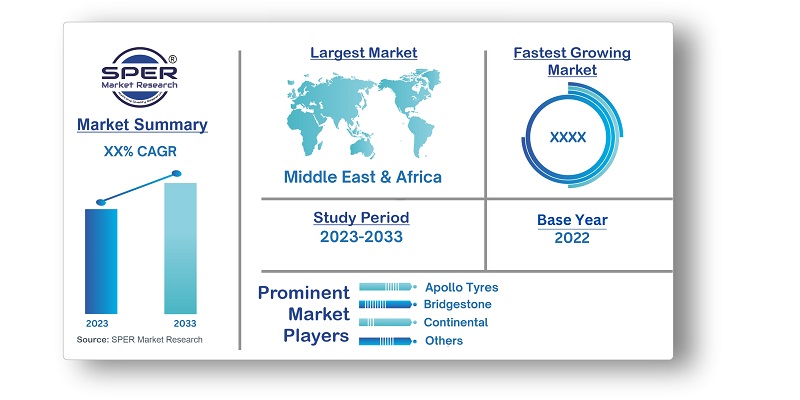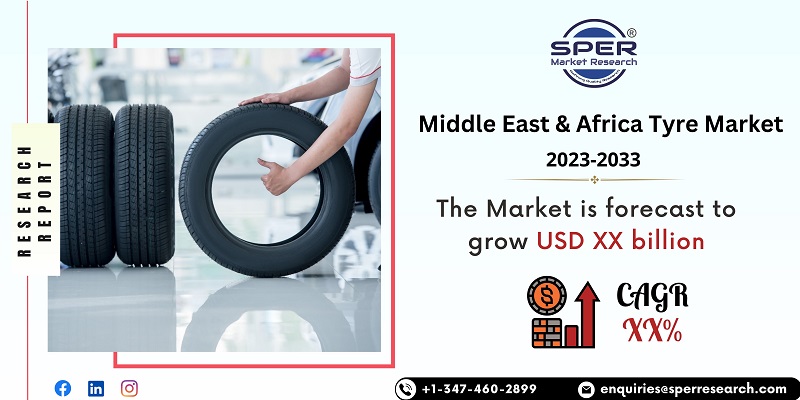
Middle East and Africa Tire (Tyre) Market Growth, Size, Trends, Revenue, Scope and Future Outlook
Middle East & Africa Tire (Tyre) Market Size- By Vehicle Type, By Design, By Sales Channel, By End User- Regional Outlook, Competitive Strategies and Segment Forecast to 2033
| Published: Jun-2023 | Report ID: AMIN2399 | Pages: 1 - 157 | Formats*: |
| Category : Automotive & Transportation | |||


| Report Metric | Details |
| Market size available for years | 2019-2033 |
| Base year considered | 2022 |
| Forecast period | 2023-2033 |
| Segments covered | By Vehicle Type, By Design, By Sales Channel, By End Use |
| Regions covered | Qatar, Saudi, South Africa, UAE, Rest of the Middle East and Africa |
| Companies Covered | Apollo Tyres, Bridgestone, Continental, Cooper Tires, Goodyear Tyres, Hankook Tire, Maxxis International, Michelin, MRF, Pirelli, others |
- Automotive Service Centers
- Consumers
- Fleet Operators
- Government and Public Sector
- Importers and distributors of tires
- Industry Associations and Trade Organizations
- Replacement Tire Retailers
- Vehicle Manufacturers
- Others
- Middle East & Africa Tire (Tyre) Market Value Share and Forecast, By Vehicle Type, 2023-2033
- 2 wheeler vehicles
- 3 wheelers
- Heavy commercial vehicles
- Light commercial vehicles
- Medium commercial vehicles
- Passenger cars
- Other vehicles
- Middle East & Africa Tire (Tyre) Market Value Share and Forecast, By Design, 2023-2033
- Bias-ply tyres
- Radial tyres
- Middle East & Africa Tire (Tyre) Market Value Share and Forecast, By Sales Channel, 2023-2033
- Offline
- Online
- Middle East & Africa Tire (Tyre) Market Value Share and Forecast, By End Use, 2023-2033
- OEM
- Replacement Tyres
- Qatar
- Saudi
- South Africa
- UAE
- Rest of the Middle East and Africa
- Middle East & Africa Tire (Tyre) Market Size (FY’2023-FY’2033)
- Overview of Middle East & Africa Tire (Tyre) Market
- Segmentation of Middle East & Africa Tire (Tyre) Market By Vehicle Type (2 wheeler vehicles, 3 wheelers, Heavy commercial vehicles, Light commercial vehicles, Medium commercial vehicles, Passenger cars, Other vehicles)
- Segmentation of Middle East & Africa Tire (Tyre) Market By Design (Bias-ply tyres, Radial tyres)
- Segmentation of Middle East & Africa Tire (Tyre) Market By Sales Channel (Offline, Online)
- Segmentation of Middle East & Africa Tire (Tyre) Market By End Use (OEM, Replacement Tyres)
- Statistical Snap of Middle East & Africa Tire (Tyre) Market
- Growth Analysis of Middle East & Africa Tire (Tyre) Market
- Problems and Challenges in Middle East & Africa Tire (Tyre) Market
- Competitive Landscape in the Middle East & Africa Tire (Tyre) Market
- Impact of COVID-19 and Demonetization on Middle East & Africa Tire (Tyre) Market
- Details on Recent Investment in Middle East & Africa Tire (Tyre) Market
- Competitive Analysis of Middle East & Africa Tire (Tyre) Market
- Key Players in the Middle East & Africa Tire (Tyre) Market
- SWOT Analysis of Middle East & Africa Tire (Tyre) Market
- Middle East & Africa Tire (Tyre) Market Future Outlook and Projections (FY’2023-FY’2033)
- Recommendations from Analyst
1.1. Scope of the report1.2. Market segment analysis
2.1. Research data source2.1.1. Secondary Data2.1.2. Primary Data2.1.3. SPER’s internal database2.1.4. Premium insight from KOL’s2.2. Market size estimation2.2.1. Top-down and Bottom-up approach2.3. Data triangulation
4.1. Driver, Restraint, Opportunity and Challenges analysis4.1.1. Drivers4.1.2. Restraints4.1.3. Opportunities4.1.4. Challenges4.2. COVID-19 Impacts of the Middle East & Africa Tire (Tyre) Market
5.1. SWOT Analysis5.1.1. Strengths5.1.2. Weaknesses5.1.3. Opportunities5.1.4. Threats5.2. PESTEL Analysis5.2.1. Political Landscape5.2.2. Economic Landscape5.2.3. Social Landscape5.2.4. Technological Landscape5.2.5. Environmental Landscape5.2.6. Legal Landscape5.3. PORTER’s Five Forces5.3.1. Bargaining power of suppliers5.3.2. Bargaining power of buyers5.3.3. Threat of Substitute5.3.4. Threat of new entrant5.3.5. Competitive rivalry5.4. Heat Map Analysis
6.1. Middle East & Africa Tire (Tyre) Market Manufacturing Base Distribution, Sales Area, Product Type6.2. Mergers & Acquisitions, Partnerships, Product Launch, and Collaboration in Middle East & Africa Tire (Tyre) Market
7.1. Middle East & Africa Tire (Tyre) Market Value Share and Forecast, By Vehicle Type, 2023-20337.2. 2 wheeler vehicles7.3. 3 wheelers7.4. Heavy commercial vehicles7.5. Light commercial vehicles7.6. Medium commercial vehicles7.7. Passenger cars7.8. Other vehicles
8.1. Middle East & Africa Tire (Tyre) Market Value Share and Forecast, By Design, 2023-20338.2. Bias-ply tyres8.3. Radial tyres
9.1. Middle East & Africa Tire (Tyre) Market Value Share and Forecast, By Sales Channel, 2023-20339.2. Offline9.3. Online
10.1. Middle East & Africa Tire (Tyre) Market Value Share and Forecast, By End Use, 2023-203310.2. OEM10.3. Replacement Tyres
11.1. Middle East & Africa Tire (Tyre) Market Size and Market Share
12.1. Middle East & Africa Tire (Tyre) Market Size and Market Share by Vehicle Type (2019-2026)12.2. Middle East & Africa Tire (Tyre) Market Size and Market Share by Vehicle Type (2027-2033)
13.1. Middle East & Africa Tire (Tyre) Market Size and Market Share by Design (2019-2026)13.2. Middle East & Africa Tire (Tyre) Market Size and Market Share by Design (2027-2033)
14.1. Middle East & Africa Tire (Tyre) Market Size and Market Share by Sales Channel (2019-2026)14.2. Middle East & Africa Tire (Tyre) Market Size and Market Share by Sales Channel (2027-2033)
15.1. Middle East & Africa Tire (Tyre) Market Size and Market Share by End Use (2019-2026)15.2. Middle East & Africa Tire (Tyre) Market Size and Market Share by End Use (2027-2033)
16.1. Middle East & Africa Tire (Tyre) Market Size and Market Share by Region (2019-2026)16.2. Middle East & Africa Tire (Tyre) Market Size and Market Share by Region (2027-2033)16.3. Qatar16.4. Saudi16.5. South Africa16.6. UAE16.7. Rest of the Middle East and Africa
17.1. Apollo Tyres17.1.1. Company details17.1.2. Financial outlook17.1.3. Product summary17.1.4. Recent developments17.2. Bridgestone17.2.1. Company details17.2.2. Financial outlook17.2.3. Product summary17.2.4. Recent developments17.3. Continental17.3.1. Company details17.3.2. Financial outlook17.3.3. Product summary17.3.4. Recent developments17.4. Cooper Tires17.4.1. Company details17.4.2. Financial outlook17.4.3. Product summary17.4.4. Recent developments17.5. Goodyear Tyres17.5.1. Company details17.5.2. Financial outlook17.5.3. Product summary17.5.4. Recent developments17.6. Hankook Tire17.6.1. Company details17.6.2. Financial outlook17.6.3. Product summary17.6.4. Recent developments17.7. Maxxis International17.7.1. Company details17.7.2. Financial outlook17.7.3. Product summary17.7.4. Recent developments17.8. Michelin17.8.1. Company details17.8.2. Financial outlook17.8.3. Product summary17.8.4. Recent developments17.9. MRF17.9.1. Company details17.9.2. Financial outlook17.9.3. Product summary17.9.4. Recent developments17.10. Pirelli17.10.1. Company details17.10.2. Financial outlook17.10.3. Product summary17.10.4. Recent developments17.11. Others
SPER Market Research’s methodology uses great emphasis on primary research to ensure that the market intelligence insights are up to date, reliable and accurate. Primary interviews are done with players involved in each phase of a supply chain to analyze the market forecasting. The secondary research method is used to help you fully understand how the future markets and the spending patterns look likes.
The report is based on in-depth qualitative and quantitative analysis of the Product Market. The quantitative analysis involves the application of various projection and sampling techniques. The qualitative analysis involves primary interviews, surveys, and vendor briefings. The data gathered as a result of these processes are validated through experts opinion. Our research methodology entails an ideal mixture of primary and secondary initiatives.



Frequently Asked Questions About This Report
PLACE AN ORDER
Year End Discount
Sample Report
Pre-Purchase Inquiry
NEED CUSTOMIZATION?
Request CustomizationCALL OR EMAIL US
100% Secure Payment






Related Reports
Our Global Clients
Our data-driven insights have influenced the strategy of 200+ reputed companies across the globe.




















